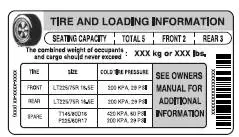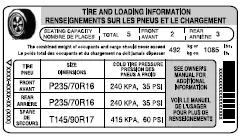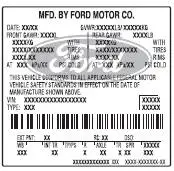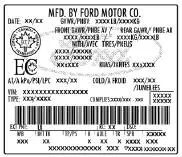Ford Mustang (2005-2014) Owners Manual: Load Carrying
LOAD LIMIT
Vehicle Loading ÔÇô With and Without a Trailer
Vehicle Loading ÔÇô With and Without a Trailer This section will guide you in the proper loading of your vehicle and/or trailer, to keep your loaded vehicle weight within its design rating capability, with or without a trailer. Properly loading your vehicle will provide maximum return of vehicle design performance. Before loading your vehicle, familiarize yourself with the following terms for determining your vehicleÔÇÖs weight ratings, with or without a trailer, from the vehicleÔÇÖs Tire Label or Safety Compliance Certification Label: Base Curb Weight ÔÇô is the weight of the vehicle including a full tank of fuel and all standard equipment. It does not include passengers, cargo, or optional equipment.
Vehicle Curb Weight ÔÇô is the weight of your new vehicle when you picked it up from your authorized dealer plus any aftermarket equipment.

Payload ÔÇô is the combined weight of cargo and passengers that the vehicle is carrying. The maximum payload for your vehicle can be found on the Tire Label on the B-Pillar or the edge of the driverÔÇÖs door (vehicles exported outside the US and Canada may not have a Tire Label). Look for ÔÇťTHE COMBINED WEIGHT OF OCCUPANTS AND CARGO SHOULD NEVER EXCEED XXX kg OR XXX lb.ÔÇŁ for maximum payload. The payload listed on the Tire Label is the maximum payload for the vehicle as built by the assembly plant. If any aftermarket or authorized-dealer installed equipment has been installed on the vehicle, the weight of the equipment must be subtracted from the payload listed on the Tire Label in order to determine the new payload.
WARNING: The appropriate loading capacity of your vehicle can be limited either by volume capacity (how much space is available) or by payload capacity (how much weight the vehicle should carry). Once you have reached the maximum payload of your vehicle, do not add more cargo, even if there is space available. Overloading or improperly loading your vehicle can contribute to loss of vehicle control and vehicle rollover.
Example only:



Cargo Weight ÔÇô includes all weight added to the Base Curb Weight, including cargo and optional equipment. When towing, trailer tongue load weight is also part of cargo weight.
GAW (Gross Axle Weight) ÔÇô is the total weight placed on each axle (front and rear) ÔÇô including vehicle curb weight and all payload.
GAWR (Gross Axle Weight Rating) ÔÇô is the maximum allowable weight that can be carried by a single axle (front or rear). These numbers are shown on the Safety Compliance Certification Label. The label shall be affixed to either the door hinge pillar, door-latch post, or the door edge that meets the door-latch post, next to the driverÔÇÖs seating position. The total load on each axle must never exceed its GAWR. Note: For trailer towing information refer to Trailer towing found in this chapter or the RV and Trailer Towing Guide provided by your authorized dealer.

GVW (Gross Vehicle Weight) ÔÇô is the Vehicle Curb Weight + cargo + passengers.
GVWR (Gross Vehicle Weight Rating) ÔÇô is the maximum allowable weight of the fully loaded vehicle (including all options, equipment, passengers and cargo). The GVWR is shown on the Safety Compliance Certification Label. The label shall be affixed to either the door hinge pillar, door-latch post, or the door edge that meets the door-latch post, next to the driverÔÇÖs seating position.
The GVW must never exceed the GVWR.
ÔÇó Example only:


WARNING: Exceeding the Safety Compliance Certification Label vehicle weight rating limits could result in substandard vehicle handling or performance, engine, transmission and/or structural damage, serious damage to the vehicle, loss of control and personal injury.

GCW (Gross Combined Weight) ÔÇô is the weight of the loaded vehicle (GVW) plus the weight of the fully loaded trailer.
GCWR (Gross Combined Weight Rating) ÔÇô is the maximum allowable weight of the vehicle and the loaded trailer ÔÇô including all cargo and passengers ÔÇô that the vehicle can handle without risking damage.
(Important: The towing vehicleÔÇÖs braking system is rated for operation at GVWR, not at GCWR. Separate functional brakes should be used for safe control of towed vehicles and for trailers where the GCW of the towing vehicle plus the trailer exceed the GVWR of the towing vehicle.
The GCW must never exceed the GCWR. Maximum Loaded Trailer Weight ÔÇô is the highest possible weight of a fully loaded trailer the vehicle can tow. It assumes a vehicle with only mandatory options, no cargo (internal or external), a tongue load of 10ÔÇô15% (conventional trailer), and driver only (150 lb. [68 kg]).
Consult your authorized dealer (or the RV and Trailer Towing Guide provided by your authorized dealer) for more detailed information.
WARNING: Do not exceed the GVWR or the GAWR specified on the Safety Compliance Certification Label.
WARNING: Do not use replacement tires with lower load carrying capacities than the original tires because they may lower the vehicleÔÇÖs GVWR and GAWR limitations. Replacement tires with a higher limit than the original tires do not increase the GVWR and GAWR limitations.
WARNING: Exceeding any vehicle weight rating limitation could result in serious damage to the vehicle and/or personal injury.
Steps for determining the correct load limit:
1. Locate the statement ÔÇťThe combined weight of occupants and cargo
should never exceed XXX kg or XXX lbs.ÔÇŁ on your vehicleÔÇÖs placard.
2. Determine the combined weight of the driver and passengers that will
be riding in your vehicle.
3. Subtract the combined weight of the driver and passengers from
XXX kg or XXX lbs.
4. The resulting figure equals the available amount of cargo and luggage
load capacity. For example, if the ÔÇťXXXÔÇŁ amount equals 1,400 lbs. and
there will be five 150 lb. passengers in your vehicle, the amount of
available cargo and luggage load capacity is 650 lbs. (1400ÔÇô750 (5 x 150)
= 650 lb.).
5. Determine the combined weight of luggage and cargo being loaded on
the vehicle. That weight may not safely exceed the available cargo and
luggage load capacity calculated in Step 4.
6. If your vehicle will be towing a trailer, load from your trailer will be
transferred to your vehicle. Consult this manual to determine how this
reduces the available cargo and luggage load capacity of your vehicle.
The following gives you a few examples on how to calculate the available amount of cargo and luggage load capacity:
ÔÇó Suppose your vehicle has a 1400 lb. (635 kg) cargo and luggage capacity. You decide to go golfing. Is there enough load capacity to carry you, 4 of your friends and all the golf bags? You and four friends average 220 lb. (99 kg) each and the golf bags weigh approximately 30 lb. (13.5 kg) each. The calculation would be: 1,400 - (5 x 220) - (5 x 30) = 1,400 - 1,100 - 150 = 150 lb. Yes, you have enough load capacity in your vehicle to transport four friends and your golf bags.
In metric units, the calculation would be: 635 kg - (5 x 99 kg) -
(5 x 13.5 kg) = 635 - 495 - 67.5 = 72.5 kg.
ÔÇó Suppose your vehicle has a 1400 lb. (635 kg) cargo and luggage
capacity. You and one of your friends decide to pick up cement from
the local home improvement store to finish that patio you have been
planning for the past 2 years. Measuring the inside of the vehicle with
the rear seat folded down, you have room for 12-100 lb. (45 kg) bags
of cement. Do you have enough load capacity to transport the cement
to your home? If you and your friend each weigh 220 lb. (99 kg), the
calculation would be: 1,400 - (2 x 220) - (12 x 100) = 1,400 - 440 -
1,200 = - 240 lb. No, you do not have enough cargo capacity to carry
that much weight. In metric units, the calculation would be: 635 kg -
(2 x 99 kg) - (12 x 45 kg) = 635 - 198 - 540 = -103 kg. You will need
to reduce the load weight by at least 240 lb. (104 kg). If you remove
3-100 lb. (45 kg) cement bags, then the load calculation would be:
1,400 - (2 x 220) - (9 x 100) = 1,400 - 440 - 900 = 60 lb. Now you
have the load capacity to transport the cement and your friend home.
In metric units, the calculation would be: 635 kg - (2 x 99 kg) - (9 x 45 kg) = 635 - 198 - 405 = 32 kg.
The above calculations also assume that the loads are positioned in your vehicle in a manner that does not overload the Front or the Rear Gross Axle Weight Rating specified for your vehicle on the Safety Compliance Certification Label. The label shall be affixed to either the door hinge pillar, door-latch post, or the door edge that meets the door-latch post, next to the driverÔÇÖs seating position.
 Driving Aids
Driving Aids
STEERING
Electric Power Steering
WARNING: The electric power steering system has diagnostic
checks that continuously monitor the system to ensure proper
operation. When a system error is detected a st ...
 Towing
Towing
...
Other materials:
Disassembly
1. CAUTION: Do not place the cylinder head flat on the bench; the
valves will bend.
CAUTION: Before disassembly begins, mark the valve position on the face of each
valve being removed. The valves must be re-installed into the same positions.
Install the spec ...
Heater Core Backflushing
Special Tool(s)
Flush Kit
164-R3658 or equivalent
Drain Kit
164-R3662 or equivalent
Material
Item
Specification
Motorcraft Premium Cooling
System Flush
VC-1 or equivalent
ESR-M14P7-A
Motorcraft Premium ...
Latch - Luggage Compartment Lid
Removal
1. NOTE: The luggage compartment lid latch is equipped with
mechanical interior release handle.
Disconnect the luggage compartment lid lock actuator (432A38) cable.
2. Remove the luggage compartment lid latch (43200).
1. Disconnect the ...
